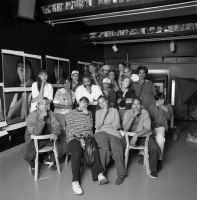Many of Dawoud Bey’s photographic portraits are of teenagers. The steady, open gazes of these black and Hispanic urban youths evidence a self-confidence and self-awareness that contradict media-propagated stereotypes. Bey’s interest in teenage subjects stems from his recognition of both their demonization in the media and their power as “arbiters of style in the community.”[1] His portraits humanize these young men and women, demonstrating their unique ability to serve as emblems of their times.
Bey’s Walker Art Center artist residency in the summer of 1995 brought him together with a group of sixteen Minneapolis teens for two weeks of photography workshops. Using first standard and later large-format Polaroid cameras, the participants created their own photographs and served as subjects for Bey’s portraits. For the artist, the interaction was about more than just finding new subjects for his own work: “It was important to me that they have a voice as well, to describe some of their own experiences. . . . In the end, it’s not just about me. . . .
Bey’s Walker Art Center artist residency in the summer of 1995 brought him together with a group of sixteen Minneapolis teens for two weeks of photography workshops. Using first standard and later large-format Polaroid cameras, the participants created their own photographs and served as subjects for Bey’s portraits. For the artist, the interaction was about more than just finding new subjects for his own work: “It was important to me that they have a voice as well, to describe some of their own experiences. . . . In the end, it’s not just about me. . . .

